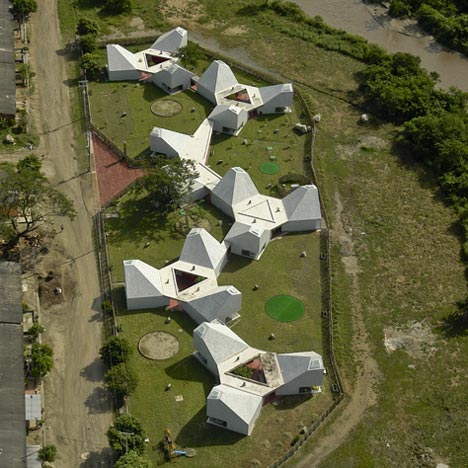
Timayui Kindergarten by el Equipo de Mazzanti
The monochrome, mosaic-clad classrooms at this preschool in Santa Marta, Colombia, are grouped into modular clusters around triangular courtyards.

Local architects el Equipo de Mazzanti designed the Timayui Kindergarten as an open-source project, hoping the format will be repeated in other communities.
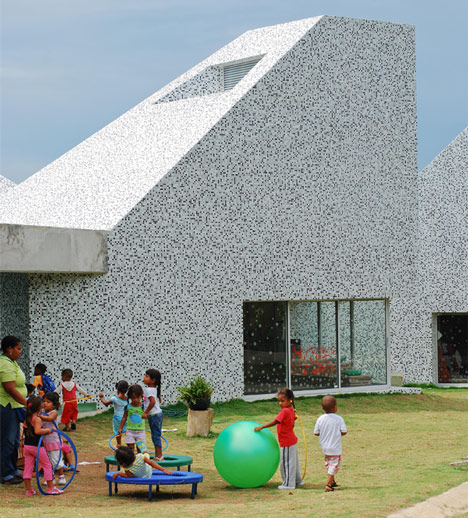
The three concrete blocks that comprise each module contain bathrooms, two classrooms and a flexible open room, which surround each central courtyard like the petals of a flower.
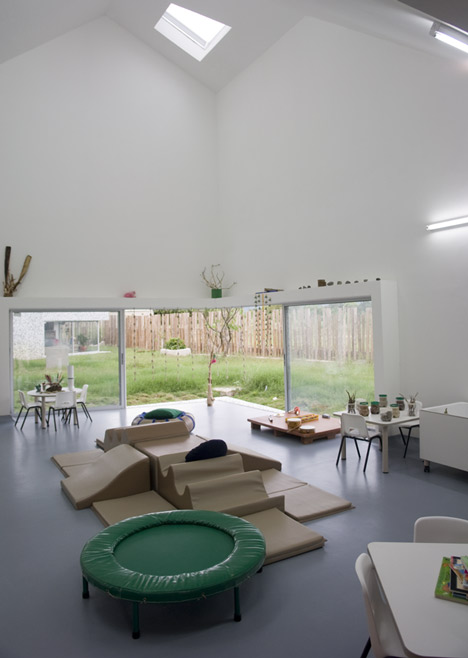
The clusters are orientated to maximise natural ventilation and daylight, while each individual block features a tapered asymmetric roof.
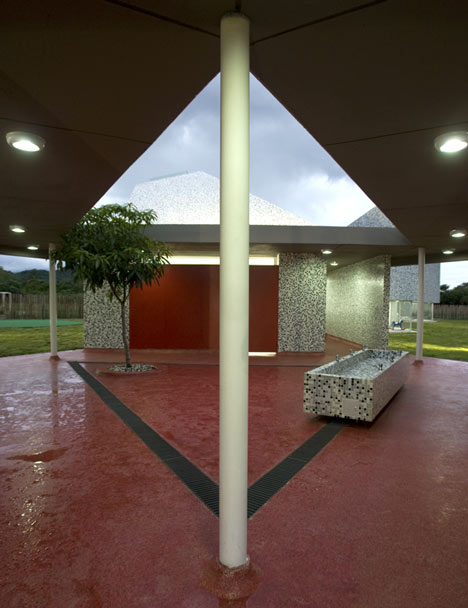
Other unusual kindergartens we've featured include one with a curving concrete orifice and another with pyramidal chimneys - take a look at them all here.
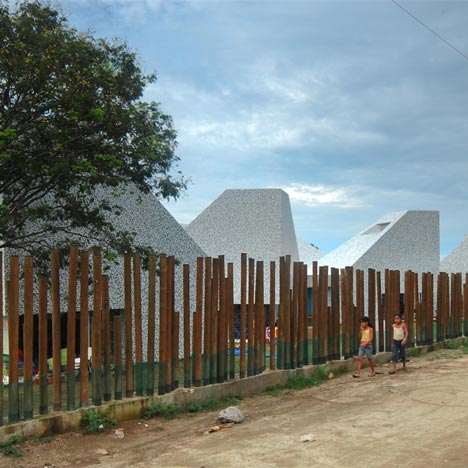
Here's a longer description from el Equipo de Mazzanti:
PRE SCHOOL FOR EARLY CHILDHOOD IN TIMAYUI,
SANTA MARTA, COLOMBIA.
1 – PROGRAM REQUIREMENTS AND PRECONDITIONS
This project is part of the political concerns of the municipality of Santa Marta and the Carulla Foundation to improve the educational and nutritional conditions of the communities displaced by violence, and settled on the outside perimeter of the city. It is meant to develop infrastructure to improve the conditions of early childhood and low-income neighbourhoods to the most vulnerable population between ages of 0 to 5 years old. These areas are characterised by violence and lack of public infrastructure.
This project encourages and develops children, and supplies a balanced and dignified diet to help improve psychomotor conditions of children for their later developments.
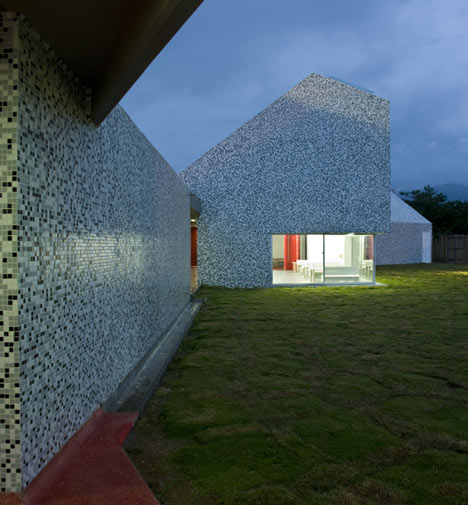
2 – THE PRESCHOOL AS A MECHANISM OF SOCIAL INCLUSION
The challenge as architects in a context like Colombia is to develop projects that can generate social inclusion. The problem lies not only in designing and constructing buildings in deteriorated areas, but to activate new forms of use, ownership and pride in the communities.
The value of architecture lies not only in itself but on what it produces. To define these arguments it is necessary to extend our gaze beyond the architecture itself. Architecture cannot only relate to itself, but widening our gaze and finding new ways to operate, to resist and be better equipped to meet the current conditions. Therefore it is necessary to transfer knowledge from other professions as dissimilar as they are, because they are likely to enable us to find more efficient and logical ways to infer in reality, issues and concerns that nurture our labor as architects and to do acting architecture. (Defined by what they do and not by their essence.)
We define some strategies used in the project that are part of the objectives of our workshop that allow us to build architecture in deteriorated areas to act and also to be used in multiple ways by their inhabitants, but especially, by allowing them to become an element of pride and transformation in the communities where they are inserted.
Architecture is action. We aim to develop the performative capacities of architecture rather than its representational abilities or visual qualities. This is why we are interested in an architecture defined by what it does and not by its substance ("Architecture is not an end in itself" Cedric Price). We would induce action, effects, events, environments, allowing us to develop ways of patterns or material organisations that act directly to induce and to build social actions with the users, an Architecture capable of inducing new behaviours and relationships among the inhabitants of these abandoned and deteriorated areas.
Open Architecture. This interest has not lead us to find open architectures capable of changing and adapting to new social and cultural challenges. We are interested in organisational systems made of parts or modules as an intelligent organisational mechanism, which is not closed or finished. Their adaptive capacity allows them to grow or adapt to diverse situations, thus allowing us to develop various models based on the same rules of organisation that can be repeated in different places of the city, making more economical and sustainable projects.
Multiply use. The Indeterminacy as a design strategy allows us to think that our Architecture is capable of multiplying the uses for which it was originally intended to (not as effectiveness, but as a pledge of new relationships). The disposition and configuration of the buildings cannot leave places not defined functionally, this means that communities can own and multiply the initial use.
Meaningful architecture. We seek to transfer conditions of the consolidated city to the periphery and deteriorated areas in which we operate. Public buildings in these zones must be identified by the communities as state presence and assistance elements of social transformation This is why we seek to develop meaningful architecture, with provisions to involve the inhabitants of the area so that they feel part of an equal society, allowing high levels of ownership and pride in the communities where our buildings are inserted.
We seek and we believe that the buildings designed in the office can become forms of social inclusion to help improve the quality factors of life and economic competitive in deteriorated poverty areas in Colombia, aiming to promote social welfare and to build a more equal and sustainable society as the ultimate goal of Architecture.
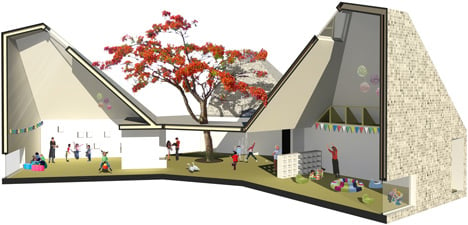
3 – JUSTIFICATION OF THE URBAN INTEGRATION OF THE PROPOSAL
The building is conceived as a visible structure, a landmark building, representing a symbol of the neighbourhood, as a primary element of the area, which by its form is different from the context that surrounds it, with no context and urban planning this will become an agglutinating element of pride for the community.
The image of the building refers to the geography of the region, rather than an object. We intend to develop an architectural landscape building that is related to the geography and topography, where it is inserted. We find rules of organisation to develop projects that promote a "new natural contract” by reformulating the relationship between figure and background, an approach in search of alternatives capable of promoting that “new natural contract” in tune with a landscape and a natural order.
The modules are implemented as a field of three-petalled flowers that are chained and distributed, allowing maximum use of the lot area designed for the preschool, an open project, with yards that are connected with the interior-exterior in a smooth way.
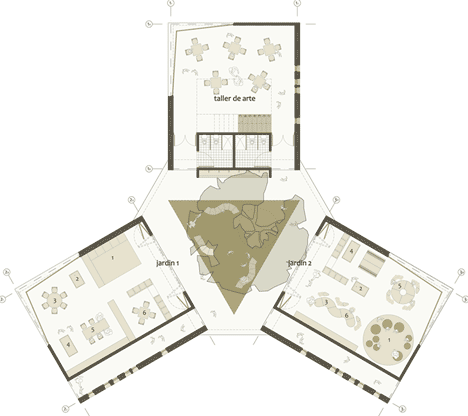
Click above for larger image
4 – JUSTIFICATION OF ADOPTED OR ORGANISATIONAL SOLUTIONS, ADAPTIVE MODULES AND SYSTEMS
The System
Our project is developing a functional strategy, and environmental space based on a modular system or repeated patterns that can be connected in various ways, allowing it to adapt to various urban educational, topographical or geometric situations.
This system builds indoor games, garden spaces and generates various educational situations: concentrated classes, outdoor covered areas, concentration of the school in a large open courtyard, scattering in various playgrounds linked to areas and to native ecosystem education, through the planting and care of endemic areas.
More than a finished and closed architecture we propose the development of an open and adaptive system, consisting of modules with the form of a flower, that can be adapted to diverse situations, whether topographical, urban or programmatic, which generate buildings able to grow, change, and adapted according to particular or temporary circumstance, a strategy that allows changes, accidents and interchangeabilities, thought a method rather than a permanent form and that only exists in virtue of its ability to change.
Two preschools are being built with this model in the areas of La Paz and Bureche on the periphery of the city of Santa Marta.
The Model
We propose the development of a flower-shaped module (each with three arms composed by a program, and a central courtyard), which can rotate at the connection ends, to make the best position on the lot in relation with the other modules, forming the chain system.
The spatial configuration starts off understanding the educational philosophy of Loris Malaguzzi, which led to the idea of creating an element that suggests 3 related centralities, and which cause a range of situations and experiences among children, teachers and families.
On the other hand, in pragmatic terms there is a need to generate steady growth for the future participation of more children towards the center, a modular system used (based on the 3 Centralities) in which modules could be added depending on the needs and possibilities of distribution. As mentioned before, this system is adaptable to different locations and diverse areas and lot locations, configuring through the addition and repetition of a module type that covers the requirements of the architectural program and in terms of space it continues the teaching method of the Center, generating meeting spaces for free entertainment involving learning.
The module type is characterized by a flexible and neutral space that allows the development of multiple activities inside, and it s also closely related to the nearest external environment [indoor and outdoor yard] thus allowing a very close relationship among all children and teachers.
ADAPTATION POSSIBILITIES OF THE MODULE
Following the morphology of the lot a chain system is created consisting of a module type that covers the requirements of the architectural program, and in terms of space, and it continues the teaching method of the Center, generating meeting spaces for the free entertainment that involves learning.
The module type is characterised for being a flexible and neutral space that allows the development of multiple activities inside, and it is also closely related to the nearest external environment [indoor and outdoor yard] allowing a very close relationship among all children and teachers. Each typical module contains bathrooms, two preschool classrooms and a sensory room which is open and connects through the yard in order to develop an educational continent identifiable by the children. The module can be adapted to other uses as a dining room and a kitchen.
The connection settings, acts like break-covered areas, education, and games, and the yards may be used for classes or recreational activities outdoors.
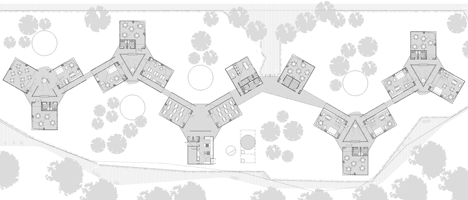
Click above for larger image
5 – GENERAL CONSTRUCTION FEATURES OF THE BUILDING
The buildings have a bearing wall system in concrete, easily implemented and of rapid construction. These walls act as support membranes removing the columns and beams of a traditional supporting system, allowing overhangs of 4 meters at the end of the classroom. These walls are covered with ceramic elements (Venetian mosaics) which contributes to the maintenance and cleaning of the building.
The building system allows the construction of 1,450 m2 in seven months, typifying or modulating the panels to be reused in other models.
Sustainable Architecture
The project aims to sustainability on several ways to improve the urban context of the population producing conscience for the future and present generations, trying to create a social and an ethical change that would cover a development model for the surrounding population.
The project has buildable and habitable conditions such as heat-regulated system through the high thermal efficiency facade retaining wall system with natural ventilation, which prevents the use of air conditioning reducing energy consumption, not only in the Kindergarten normal maintenance, but also the wall construction system reduces energy consumption on site, the materials used minimize the amount of waste from the work by lowering the environmental impact. The orientation of the building is south-north, its architectural configuration allows natural ventilation and natural lighting. The project includes areas with floral decoration, gardens for urban agriculture to contribute and to improve environmental quality and economic landscape of the urban environment and population.
It optimizes the use of water by using saving devices, recycling rain and waste water for use in bathrooms, and crops. Should it be additional water, it can benefit the surrounding community. Waste recycling is done from the source so it could be delivered to the collection system by lowering the cost of this service, and at the same time generating revenue to be used in the garden, in the case of the sale of recyclable materials. The waste produced in the kitchen is used to generate compost used later to crop areas. The project is socially committed not only to be a garden to support social welfare in early childhood, but also to support agriculture through urban families by promoting the use of natural resources with an economic purpose and remuneration for personal use.
"Agriculture and urban productivity"
"The project" Urban Agriculture", contributes to provide food and nutrition, environmental sustainability, social construction, consolidation of integral processes of participation, involvement and ownership of the territory”, a way to overcome poverty and exclusion that affects a large percentage of the population ... ... .. "
The project implements agriculture and productivity as a thematic complement to the development of educational activities, it is intended, as expressed above, to give the community and the individuals the opportunity to be productive, for their own benefit. The agricultural project is a productive instrument based on social cohesion, ownership of the territory, decrease in violence and alimentary support.
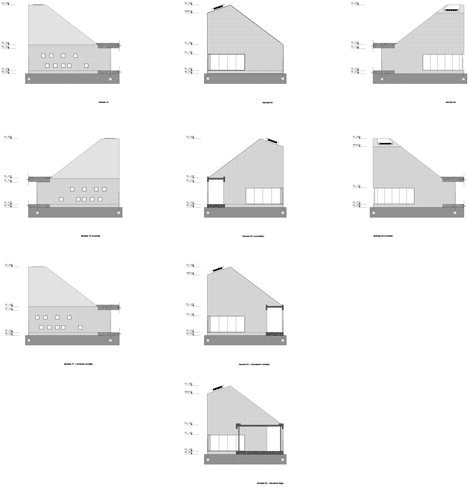
Click above for larger image
6 – THE SCHOOL ARCHITECTURE AS PLACE OF FORMATION
Architecture is capable of generating actions and learning situations and we believe the school space is in itself a learning mechanism, as we are able to teach a child in early childhood the use of materials of what is soft vs. hard, open vs. closed, hot vs. cold, and the use of many other options.
The model seeks to evaluate each school place as a place of formation. this not only takes place inside the classrooms but also in the empty spaces of the circulations and the yards as variable places capable of assuming changes in activities, outer space events. A place for games, dreams and roles.
This search presupposes the research to create learning environments (thematisations) rather than Architecture. The goal is to evolve from an abstract organisation system to an environmental system with relations.(educational continent), in which the objects are not only working for disposal, but they are created through interaction. System environments, (a machine of perspective) betting on a sequence of linear, thematic and changing routes versus the distribution spaces which are not able to enhance the appearance of indeterminate spaces for multitude events. Therefore spaces were proposed with the following characteristics of formation:
The school space as part of the hidden curriculum - the school environment as a teaching tool. Themed spaces - the speech corner, dolls´ room, etc.. the school space as a place of coexistence and relations. The sub space yards for the school community to meet. The school as aesthetic space. The image as a guide to the world - trees, animal tracks - etc. The academic Space as the territory for the meaning .- Reference to areas of the city, squares-authority - my space, subspace, etc.